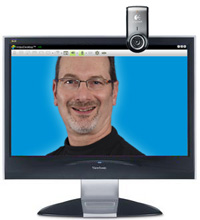Vidyo telepresence aims to transform health care


Vidyo's business is to transform Cisco's expensive Telepresence technology (as seen on TV) into something useful with any standard H.264 codec. In health care, that means quality that can deliver real consults among professionals, or with patients, dramatically lowering costs and improving quality.
Senior vice president of marketing Marty Hollander (right, from Vidyo) explained all this to ZDNet.
"A lot of people think of telepresence as an immersive experience that allows you to suspend disbelief that you're not in the same room. The real value is that you see people face to face. You are seeing them in a quality that allows you to see details of their personal reaction."
VidyoHealth works through a dedicated router that can reach deep within a hospital's network or over the broader Internet, with low latency and end-to-end encryption, so the solution is in compliance with HIPAA regulations.
"I was at a meeting this morning with 41 people, from home. It was 7 o'clock, and people were in from all over the world. Our country manager for Asia-Pacific was in a hotel, and two people called in from cellphones. We were able to do it in 1080p quality" thanks to the error resiliency built into Vidyo's system, he said.
"Where you really want to see the benefit is when you look at he applications enabled by using the Internet. We're talking about home-bound patients, for instance, who might interact with providers. That would change the economics and quality of care. That's an Internet based solution.
"Physicians could work from home just as we do, before they go in to do operations.
"Then imagine if you could use wireless networks and get this high quality video. You could get high quality interaction in an emergency vehicle. Psychiatrists could work with patients coming to a kiosk. It can be offered as a service."
Vidyo has been doing this sort of thing for some time. It was founded in 2005 as an OEM company, selling its Software Development Kits through companies like Shoretel. So why the roll-out?
"What we're doing with this launch is making a large number of people aware of what we're doing. You need to prove you can take this out to patients That will stimulate people to see that video health is the way to go."
What would you do with really high quality videoconferencing? Will it transform medicine, or just raise costs?